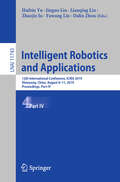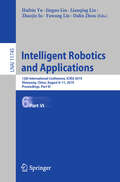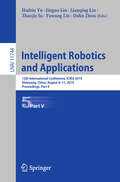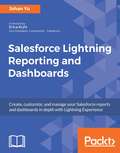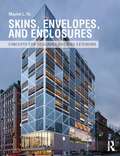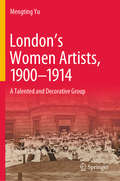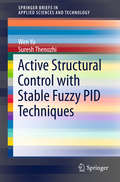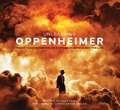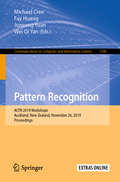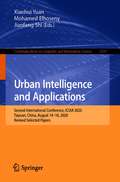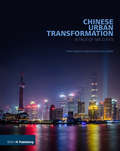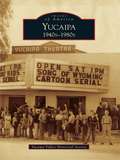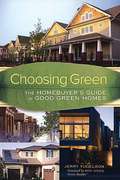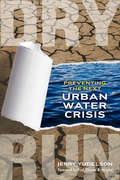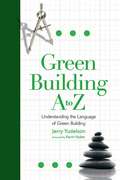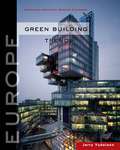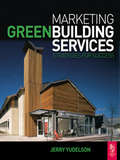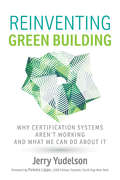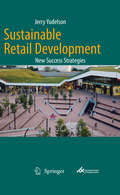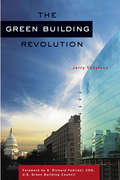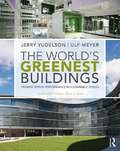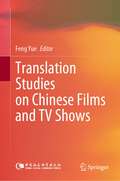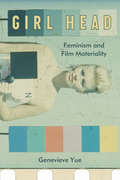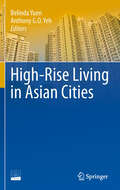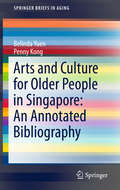- Table View
- List View
Intelligent Robotics and Applications: 12th International Conference, ICIRA 2019, Shenyang, China, August 8–11, 2019, Proceedings, Part IV (Lecture Notes in Computer Science #11743)
by Haibin Yu Jinguo Liu Lianqing Liu Zhaojie Ju Yuwang Liu Dalin ZhouThe volume set LNAI 11740 until LNAI 11745 constitutes the proceedings of the 12th International Conference on Intelligent Robotics and Applications, ICIRA 2019, held in Shenyang, China, in August 2019. The total of 378 full and 25 short papers presented in these proceedings was carefully reviewed and selected from 522 submissions. The papers are organized in topical sections as follows:Part I: collective and social robots; human biomechanics and human-centered robotics; robotics for cell manipulation and characterization; field robots; compliant mechanisms; robotic grasping and manipulation with incomplete information and strong disturbance; human-centered robotics; development of high-performance joint drive for robots; modular robots and other mechatronic systems; compliant manipulation learning and control for lightweight robot. Part II: power-assisted system and control; bio-inspired wall climbing robot; underwater acoustic and optical signal processing for environmental cognition; piezoelectric actuators and micro-nano manipulations; robot vision and scene understanding; visual and motional learning in robotics; signal processing and underwater bionic robots; soft locomotion robot; teleoperation robot; autonomous control of unmanned aircraft systems. Part III: marine bio-inspired robotics and soft robotics: materials, mechanisms, modelling, and control; robot intelligence technologies and system integration; continuum mechanisms and robots; unmanned underwater vehicles; intelligent robots for environment detection or fine manipulation; parallel robotics; human-robot collaboration; swarm intelligence and multi-robot cooperation; adaptive and learning control system; wearable and assistive devices and robots for healthcare; nonlinear systems and control. Part IV: swarm intelligence unmanned system; computational intelligence inspired robot navigation and SLAM; fuzzy modelling for automation, control, and robotics; development of ultra-thin-film, flexible sensors, and tactile sensation; robotic technology for deep space exploration; wearable sensing based limb motor function rehabilitation; pattern recognition and machine learning; navigation/localization. Part V: robot legged locomotion; advanced measurement and machine vision system; man-machine interactions; fault detection, testing and diagnosis; estimation and identification; mobile robots and intelligent autonomous systems; robotic vision, recognition and reconstruction; robot mechanism and design. Part VI: robot motion analysis and planning; robot design, development and control; medical robot; robot intelligence, learning and linguistics; motion control; computer integrated manufacturing; robot cooperation; virtual and augmented reality; education in mechatronics engineering; robotic drilling and sampling technology; automotive systems; mechatronics in energy systems; human-robot interaction.
Intelligent Robotics and Applications: 12th International Conference, ICIRA 2019, Shenyang, China, August 8–11, 2019, Proceedings, Part VI (Lecture Notes in Computer Science #11745)
by Haibin Yu Jinguo Liu Lianqing Liu Zhaojie Ju Yuwang Liu Dalin ZhouThe volume set LNAI 11740 until LNAI 11745 constitutes the proceedings of the 12th International Conference on Intelligent Robotics and Applications, ICIRA 2019, held in Shenyang, China, in August 2019. The total of 378 full and 25 short papers presented in these proceedings was carefully reviewed and selected from 522 submissions. The papers are organized in topical sections as follows:Part I: collective and social robots; human biomechanics and human-centered robotics; robotics for cell manipulation and characterization; field robots; compliant mechanisms; robotic grasping and manipulation with incomplete information and strong disturbance; human-centered robotics; development of high-performance joint drive for robots; modular robots and other mechatronic systems; compliant manipulation learning and control for lightweight robot. Part II: power-assisted system and control; bio-inspired wall climbing robot; underwater acoustic and optical signal processing for environmental cognition; piezoelectric actuators and micro-nano manipulations; robot vision and scene understanding; visual and motional learning in robotics; signal processing and underwater bionic robots; soft locomotion robot; teleoperation robot; autonomous control of unmanned aircraft systems. Part III: marine bio-inspired robotics and soft robotics: materials, mechanisms, modelling, and control; robot intelligence technologies and system integration; continuum mechanisms and robots; unmanned underwater vehicles; intelligent robots for environment detection or fine manipulation; parallel robotics; human-robot collaboration; swarm intelligence and multi-robot cooperation; adaptive and learning control system; wearable and assistive devices and robots for healthcare; nonlinear systems and control. Part IV: swarm intelligence unmanned system; computational intelligence inspired robot navigation and SLAM; fuzzy modelling for automation, control, and robotics; development of ultra-thin-film, flexible sensors, and tactile sensation; robotic technology for deep space exploration; wearable sensing based limb motor function rehabilitation; pattern recognition and machine learning; navigation/localization. Part V: robot legged locomotion; advanced measurement and machine vision system; man-machine interactions; fault detection, testing and diagnosis; estimation and identification; mobile robots and intelligent autonomous systems; robotic vision, recognition and reconstruction; robot mechanism and design. Part VI: robot motion analysis and planning; robot design, development and control; medical robot; robot intelligence, learning and linguistics; motion control; computer integrated manufacturing; robot cooperation; virtual and augmented reality; education in mechatronics engineering; robotic drilling and sampling technology; automotive systems; mechatronics in energy systems; human-robot interaction.
Intelligent Robotics and Applications: 12th International Conference, ICIRA 2019, Shenyang, China, August 8–11, 2019, Proceedings, Part V (Lecture Notes in Computer Science #11744)
by Haibin Yu Jinguo Liu Lianqing Liu Zhaojie Ju Yuwang Liu Dalin ZhouThe volume set LNAI 11740 until LNAI 11745 constitutes the proceedings of the 12th International Conference on Intelligent Robotics and Applications, ICIRA 2019, held in Shenyang, China, in August 2019. The total of 378 full and 25 short papers presented in these proceedings was carefully reviewed and selected from 522 submissions. The papers are organized in topical sections as follows:Part I: collective and social robots; human biomechanics and human-centered robotics; robotics for cell manipulation and characterization; field robots; compliant mechanisms; robotic grasping and manipulation with incomplete information and strong disturbance; human-centered robotics; development of high-performance joint drive for robots; modular robots and other mechatronic systems; compliant manipulation learning and control for lightweight robot. Part II: power-assisted system and control; bio-inspired wall climbing robot; underwater acoustic and optical signal processing for environmental cognition; piezoelectric actuators and micro-nano manipulations; robot vision and scene understanding; visual and motional learning in robotics; signal processing and underwater bionic robots; soft locomotion robot; teleoperation robot; autonomous control of unmanned aircraft systems. Part III: marine bio-inspired robotics and soft robotics: materials, mechanisms, modelling, and control; robot intelligence technologies and system integration; continuum mechanisms and robots; unmanned underwater vehicles; intelligent robots for environment detection or fine manipulation; parallel robotics; human-robot collaboration; swarm intelligence and multi-robot cooperation; adaptive and learning control system; wearable and assistive devices and robots for healthcare; nonlinear systems and control. Part IV: swarm intelligence unmanned system; computational intelligence inspired robot navigation and SLAM; fuzzy modelling for automation, control, and robotics; development of ultra-thin-film, flexible sensors, and tactile sensation; robotic technology for deep space exploration; wearable sensing based limb motor function rehabilitation; pattern recognition and machine learning; navigation/localization. Part V: robot legged locomotion; advanced measurement and machine vision system; man-machine interactions; fault detection, testing and diagnosis; estimation and identification; mobile robots and intelligent autonomous systems; robotic vision, recognition and reconstruction; robot mechanism and design. Part VI: robot motion analysis and planning; robot design, development and control; medical robot; robot intelligence, learning and linguistics; motion control; computer integrated manufacturing; robot cooperation; virtual and augmented reality; education in mechatronics engineering; robotic drilling and sampling technology; automotive systems; mechatronics in energy systems; human-robot interaction.
Salesforce Lightning Reporting and Dashboards
by Johan YuLearn how to build advanced reports and dashboards in Salesforce Lightning experience About This Book • Visualize and create advanced reports and dashboards using Lightning Experience • Improve overall business efficiency with advanced and effective reports and dashboards • Understand and create custom reports and dashboards Who This Book Is For This book is targeted at Salesforce.com administrators, business analysts, and managers who use Salesforce.com for their daily job and want to learn in depth about Salesforce Reporting and Dashboard in Lightning Experience. Readers should have a basic knowledge of Salesforce, such as: Accounts, Contacts, Leads, Opportunities and custom objects. What You Will Learn • Navigate in Salesforce.com within the Lightning Experience user interface • Secure and share your reports and dashboards with other users • Create, manage, and maintain reports using Report Builder • Learn how the report type can affect the report generated • Explore the report and dashboard folder and the sharing model • Create reports with multiple formats and custom report types • Explore various dashboard features in Lightning Experience • Use Salesforce1, including accessing reports and dashboards In Detail Built on the Salesforce App Cloud, the new Lightning Experience combines the new Lightning Design System, Lightning App Builder, and Lightning Components to enable anyone to quickly and easily create modern enterprise apps. The book will start with a gentle introduction to the basics of Salesforce reports and dashboards. It will also explain how to access reports in depth. Then you will learn how to create and manage reports, to use Schedule Report, and create advanced report configurations. The next section talks about dashboards and will enable you to understand and compare various types of dashboard component and how you can benefit the most from each of them. Then we move on to advanced topics and explain tips and tricks related to reports and dashboards, including reporting snapshots, report parameters, and collaboration. Finally, we will discuss how to access dashboards and reports from the Salesforce1 mobile app. Style and approach This comprehensive guide covers the advanced features of the all new Salesforce Lightning concepts and communicates them through a practical approach to explore the underlying concepts of how, when, and why to use them.
Skins, Envelopes, and Enclosures: Concepts for Designing Building Exteriors
by Mayine L. YuIntegrate the best building envelope construction methods, materials science, and structural principles in your work using this book as a resource to help you… With more than seventy significant case studies located in North America, South America, Europe, and Asia from prehistory to the present, this book illuminates the theory and techniques of assembling exteriors. Six chapters organized by wall types, from hand-set monolithic walls to digitally fabricated curtain walls, each have a material focus section to help you understand their intrinsic properties so that you can decide which will best keep the weather out of your building. Examples from the ancient world, including the Pyramids and the Great Wall, through a range of renowned modern architects, such as Studio Gang, Sauerbruch Hutton, Herzog and deMeuron, and Rafael Moneo, illustrate how significant works in the history of architecture explored innovative use of materials – stone, brick, concrete, glass, and aluminium. Along the way, principles of construction from masonry and basic framing through ever more sophisticated envelope systems address classic problems presented by gravity, wind, rain, and sun with studies of lateral forces, building movements and materials that bridge the gaps in between them.
London’s Women Artists, 1900-1914: A Talented and Decorative Group
by Mengting YuDrawing on untapped archives, as well as aggregating a wide range of existing published sources, this book recalibrates the understanding of women artists’ roles, outputs and receptions in London during what was indubitably a vibrant and innovative period in the history of British art, and in which the work of their male contemporaries is so well understood. The book takes its starting point from Alicia Foster’s article “Gwen John’s Self-Portrait: Art, Identity and Women Students at the Slade School,” published in 2000, where the expression “a talented and decorative group” was coined to describe common attitudes towards women artists in the late 19th and early 20th century London. This pejorative attribution strongly implied a status less significant to that of their male counterparts. The author challenges this statement's basic tenet by casting a wide net in examining women’s art education from the Slade School of Fine Art, through to the role of its graduates within a selection of London’s exhibition groups, societies and publications. This book also reconstructs ‘from scratch’ the role of the Women’s International Art Club (WIAC), hitherto entirely overlooked in art historical studies of the era. This book will be of interest to students and researchers in art and cultural history, gender studies,and in sociological studies of pre-War World War Britain.
Active Structural Control with Stable Fuzzy PID Techniques (SpringerBriefs in Applied Sciences and Technology)
by Wen Yu Suresh ThenozhiThis book presents a detailed discussion of intelligenttechniques to measure the displacement of buildings when they are subjected tovibration. It shows how these techniques are used to control active devicesthat can reduce vibration 60-80% more effectively than widely used passiveanti-seismic systems. After introducing various structural control devices andbuilding-modeling and active structural control methods, the authors proposeoffset cancellation and high-pass filtering techniques to solve some commonproblems of building-displacement measurement using accelerometers. The mostpopular control algorithms in industrial settings, PD/PID controllers, are thenanalyzed and then combined with fuzzy compensation. The stability of thiscombination is proven with standard weight-training algorithms. These conditionsprovide explicit methods for selecting PD/PID controllers. Finally, fuzzy-logicand sliding-mode control are applied to the control of wind-induced vibration. The methods described are supported by reports of experimental studies on atwo-story building prototype. This book is avaluable resource for academic researchers interested in the effects of controland mechatronic devices within buildings, or those studying the principles ofvibration reduction. Practicing engineers working on the design andconstruction of any sort of high-rise or vulnerable building and concerned withthe effects of either wind or seismic disturbances benefit from the efficacy ofthe methods proposed.
Unleashing Oppenheimer: Inside Christopher Nolan's Explosive Atomic-Age Thriller
by Jada YuanDiscover the secrets of Christopher Nolan&’s Oppenheimer with this exclusive behind-the-scenes look at 2023&’s most anticipated film.Written and directed by Christopher Nolan, Oppenheimer is an IMAX®-shot epic thriller that thrusts audiences into the pulse-pounding paradox of the enigmatic man who must risk destroying the world in order to save it. The film is produced by Emma Thomas, Charles Roven, and Nolan. The film stars Cillian Murphy as J. Robert Oppenheimer and Emily Blunt as Katherine &“Kitty&” Oppenheimer. Oscar® winner Matt Damon portrays General Leslie Groves Jr. and Robert Downey Jr. plays Lewis Strauss. Unleashing Oppenheimer traces the creation of Nolan&’s latest film from script to screen through exclusive interviews with the director and his cast and crew, plus electrifying visuals from the film including on-set photos, concept art, research materials, and storyboards. CHRISTOPHER NOLAN: Dive into the creative process of the award-winning director and get an insider&’s view of his latest film. STAR-STUDDED CAST: The highly anticipated Oppenheimer features a stunning cast, including Cillian Murphy, Emily Blunt, Matt Damon, Robert Downey Jr., Florence Pugh, Benny Safdie, Josh Hartnett, and Kenneth Branagh. EXCLUSIVE INTERVIEWS: This book includes an all-access account of the creation of the film with interviews with key players, including Christopher Nolan himself.
Pattern Recognition: ACPR 2019 Workshops, Auckland, New Zealand, November 26, 2019, Proceedings (Communications in Computer and Information Science #1180)
by Junsong Yuan Wei Qi Yan Fay Huang Michael CreeThis volume constitutes the refereed proceedings, presented during the ACPR 2019 Workshops, held in Auckland, New Zealand, in November 2019. The 17 full papers and 6 short papers were carefully reviewed and selected out of numerous submissions. The papers are organized according to the topics of the workshops: computer vision for modern vehicles; advances and applications on generative deep learning models; image and pattern analysis for multidisciplinary computational anatomy; multi-sensor for action and gesture recognition; towards the automatic data processing chain for airborne and spaceborne sensors.
Urban Intelligence and Applications: Second International Conference, ICUIA 2020, Taiyuan, China, August 14–16, 2020, Revised Selected Papers (Communications in Computer and Information Science #1319)
by Xiaohui Yuan Mohamed Elhoseny Jianfang ShiThis book constitutes revised papers from the Second International Conference on Urban Intelligence and Applications, ICUIA 2020, held in August 2020. Due to the COVID-19 pandemic the conference was held online. The 26 papers were thoroughly reviewed and selected from 122 submissions. They are organised in the topical sections on technology and infrastructure; community and wellbeing; mobility and transportation; security, safety, and emergency management.
Chinese Urban Transformation: A Tale of Six Cities
by Chen Yuanzhi Alan Hudson He LishengNow an established global force, China has experienced a sustained period of staggering economic growth since policy reform in the 1970s. Chinese urbanisation is the most significant example of economic, environmental and social change both within China and globally. In recent years, central government has made a concerted effort to encourage city governments to realign their priorities and achieve a balance between economic efficiency, social justice and environmental protection. Chinese Urban Transformation: A Tale of Six Cities is a fascinating exploration of the dramatic development Chinese cities have undergone. Tracing this transformation through a comprehensive analysis of social and economic change in six cities, it unravels the complex relationship between policy, outlook and role that urban development plays in China’s view of itself, including the tensions resulting from rapid social and economic change.
Yucaipa: 1940s-1980s
by Yucaipa Valley Historical SocietyWhen the soldiers returned after the end of World War II, the community of Yucaipa celebrated the victory and settled into a new era that would someday become known as the "good old days." Located in the foothills of the San Bernardino Mountains at the edge of the desert, the area and the climate was perfect for not only maintaining the agriculture-based economy, but establishing more businesses, churches, schools, and whole new neighborhoods. The first tracts of homes were followed with mobile home parks for new retirees looking for a real hometown, which they found in Yucaipa. People raised their children in a village-style environment, and the whole family could enjoy life with enthusiasm. There was plenty to do, and traditions that are continuing today were established in the form of parades, fairs, sports programs, and the enrichment opportunities of good schools, a college, and the community's love of its land and each other.
Choosing Green: The Homebuyer's Guide to Good Green Homes
by Jerry YudelsonDrawing from the expertise of dozens of homebuilders, government officials, and green home experts, Choosing Green deftly takes the reader through these considerations with easy-to-use tables, charts, maps, score sheets, and checklists. The book includes a glossary of green building terms, an extensive resource section, and a list of homebuilders, green rating programs, and financial incentives. This comprehensive book provides home buyers with every thing they will need to make a successful search for their own green home.
Dry Run
by Jerry YudelsonIn the Age of Scarcity now upon us, fresh water shortages are an increasingly serious global problem. With water restrictions emerging in many developed countries and water diversions for industrial, urban, and environmental reasons stirring up oceans of controversy, there is a growing thirst for innovative approaches to reducing our water footprint. Dry Run shows the best ways to manage scarce water resources and handle upcoming urban water crises. Featuring original interviews with more than twenty-five water researchers and industry experts, this book explains water issues and proposes solutions for homes, buildings, facilities, and schools. Examining the vital linkages between water, energy use, urban development, and climate change, Dry Run demonstrates best practices for achieving "net zero" water use in the built environment, including: Water conservation strategies for buildings, factories, cities, and homes Rainwater harvesting Graywater reuse and water reclamation systems Water efficiency retrofits On-site sewage treatment New water reuse and supply technologies Ideal for concerned citizens, building managers, homeowners, architects, engineers, developers, and public officials faced with charting a course in a more arid future, Dry Run overflows with practical solutions. Jerry Yudelson, PE, LEED AP, leads the Yudelson Associates consultancy and is a leading authority on green building, clean water, and sustainable development. He is the author of eleven books, including Choosing Green and Green Building A to Z.
Green Building A to Z
by Jerry YudelsonGreen building is the fastest-growing trend to hit since the Internet, bringing with it an enormous range of new products, systems, and technologies. Green Building A to Z is an informative, technically accurate, and highly visual guide to green building, for both decision-makers and interested citizens. It begins with an introduction to the importance of green buildings and a brief history of the green building movement, outlines the benefits and costs of green buildings, and shows how you can influence the spread of green buildings. The book touches on key issues, such as enhancing water conservation, reducing energy use, and creating a conservation economy. The book examines all aspects of green buildings, including: Architecture 2030 Locally sourced materials Natural ventilation Solar energy Zero-net-energy buildings More than just a reference, this book emphasizes the importance of green buildings and green developments for a sustainable future. It will be an invaluable resource for businesspeople, homeowners, product manufacturers, developers, building industry professionals, and government officials.
Green Building Trends: Europe
by Jerry YudelsonThe "green building revolution" is a worldwide movement for energy-efficient, environmentally aware architecture and design. Europe has been in the forefront of green building technology, and Green Building Trends: Europe provides an indispensable overview of these cutting edge ideas and applications. In order to write this book, well-known U.S. green building expert Jerry Yudelson interviewed a number of Europe's leading architects and engineers and visited many exemplary projects. With the help of copious photographs and illustrations, Yudelson describes some of the leading contemporary green buildings in Europe, including the new Lufthansa headquarters in Frankfurt, the Norddeutsche Landesbank in Hannover, a new school at University College London, the Beaufort Court Zero-Emissions building, the Merck Serono headquarters in Geneva, and a zero-net-energy, all-glass house in Stuttgart. In clear, jargon-free prose, Yudelson provides profiles of progress in the journey towards sustainability, describes the current regulatory and business climates, and predicts what the near future may bring. He also provides a primer on new technologies, systems, and regulatory approaches in Western Europe that can be adopted in North America, including building-integrated solar technologies, radiant heating and cooling systems, dynamic façades that provide natural ventilation, innovative methods for combining climate control and water features in larger buildings, zero-netenergy homes built like Thermos bottles, and strict government timetables for achieving zero-carbon buildings. Green Building Trends: Europe is an essential resource for anyone interested in the latest developments in this rapidly growing field.
Marketing Green Building Services: Strategies For Success
by Jerry YudelsonMarketing Green Building Services: Strategies for Success presents all the information key decision-makers need to respond to the fast-growing market for green buildings, design and construction services and products. Completely updated, revised and expanded from the author’s previous works, this book is the one resource you need to succeed in the green building marketplace.With a sound grounding in contemporary marketing theory and practice, the book assembles hard-to-find information to assist executives and partners in design and construction firms in crafting competitive strategies that build on their firm’ strengths, while shoring up their weaknesses. Since most design and construction firms specialize in particular market sectors, the book systematically examines the important market segments for green buildings. It also presents key business case justifications for green buildings that help architects, engineers and builders to understand client motivations and respond to them with appropriate marketing tactics and communications strategies. The book examines how the green building market is adopting certain new products and design approaches, information that will help manufacturers and product sales teams to craft appropriate marketing strategies. The book also helps owners and developers understand the green building business case and to find out what other leading-edge firms and projects have learned - how to market and sell green buildings and green developments in a highly competitive marketplace.
Reinventing green building
by Jerry YudelsonBuildings and their associated systems are the largest source of greenhouse gases in the world. The 2030 Challenge aims to produce zero net -energy from new North American construction by 2030 while achieving a 50% reduction in carbon emissions from existing buildings. With less than 4% of commercial and residential structures in the U. S. and Canada certified by 2015, we seem destined to fall catastrophically short of this target. Reinventing Green Building combines a unique, insider's critique of the current state of affairs with a potent vision for the future. This highly visual, data-driven analysis brings together the wisdom of today's leading practitioners including: Up-to-date information on green building issues, energy economics and new technology Dramatic new approaches to certification system design and user experience Creative, outside-the-box solutions using the Internet of Things, big data analytics and cloud-based technologies for building management. The green building revolution has failed to fulfill its promise to transform the marketplace in a meaningful way. Smart, simple, and sustainable: Reinventing Green Building presents a new approach to building certification, designed to radically cut costs while dramatically increasing marketplace acceptance integrating true climate mitigation and better building performance.
Sustainable Retail Development: New Success Strategies
by Jerry YudelsonSustainable Retail Development, addresses the emerging issue of green retail buildings and retail development that will grow significantly in importance over the next half-decade, a trend seen throughout the developed world. This volume is a practical and comprehensive guide to greening retail real estate, including green building and marketing strategies, corporate sustainability programs and features a 10-point "action program" for greening any retail real estate portfolio. Sustainable Retail Development, should be essential reading for professionals in design, construction and operations of shopping centers and retail stores. Well illustrated, this volume features over 30 green retail developments from North America, Europe, South America, Asia and Australia, as well as interviews with 25 leading industry experts.
The Green Building Revolution
by Jerry Yudelson S. Richard FedrizziThe "green building revolution'' is happening right now. This book is its chronicle and its manifesto. Written by industry insider Jerry Yudelson, The Green Building Revolution introduces readers to the basics of green building and to the projects and people that are advancing this movement. With interviews and case studies, it does more than simply report on the revolution; it shows readers why and how to start thinking about designing, building, and operating high performance, environmentally aware (LEED-certified) buildings on conventional budgets. Evolving quietly for more than a decade, the green building movement has found its voice. Its principles of human-centered, environmentally sensitive development have reached a critical mass of architects, engineers, builders, developers, professionals in government, and consumers. Green buildings are showing us how we can have healthier indoor environments that use far less energy and water than conventional buildings do. The federal government, eighteen states, and nearly fifty U.S. cities already require new public buildings to meet "green" standards. According to Yudelson, this is just the beginning. The Green Building Revolution describes the many "revolutions" that are taking place today: in commercial buildings, schools, universities, public buildings, health care institutions, housing, property management, and neighborhood design. In a clear, highly readable style, Yudelson outlines the broader "journey to sustainability" influenced by the green building revolution and provides a solid business case for accelerating this trend. Illustrated with more than 50 photos, tables, and charts, and filled with timely information, The Green Building Revolution is the definitive description of a major movement that's poised to transform our world.
The World's Greenest Buildings: Promise Versus Performance in Sustainable Design
by Jerry Yudelson Ulf MeyerThe World’s Greenest Buildings tackles an audacious task. Among the thousands of green buildings out there, which are the best, and how do we know? Authors Jerry Yudelson and Ulf Meyer examined hundreds of the highest-rated large green buildings from around the world and asked their owners to supply one simple thing: actual performance data, to demonstrate their claims to sustainable operations. This pivotal book presents: an overview of the rating systems and shows "best in class" building performance in North America, Europe, the Middle East, India, China, Australia and the Asia-Pacific region practical examples of best practices for greening both new and existing buildings a practical reference for how green buildings actually perform at the highest level, one that takes you step-by-step through many different design solutions a wealth of exemplary case studies of successful green building projects using actual performance data from which to learn interviews with architects, engineers, building owners and developers and industry experts, to provide added insight into the greening process This guide uncovers some of the pitfalls that lie ahead for sustainable design, and points the way toward much faster progress in the decade ahead.
Translation Studies on Chinese Films and TV Shows
by Feng YueThis book explores translation strategies for films and TV programs. On the basis of case studies on subtitle translations, it argues that translators are expected to take into consideration not only linguistic and cultural differences but also the limits of time and space. Based on the editor’s experience working as a translator for TV, journalist, and narrator, this book proposes employing editorial translation for TV translation. Further, in light of statistics on international audiences’ views on Chinese films, it suggests striking a balance between conveying cultural messages and providing good entertainment.
Girl Head: Feminism and Film Materiality
by Genevieve YueGirl Head shows how gender has had a surprising and persistent role in film production processes, well before the image ever appears onscreen.For decades, feminist film criticism has focused on issues of representation: images of women in film. But what are the feminist implications of the material object underlying that image, the filmstrip itself? What does feminist analysis have to offer in understanding the film image before it enters the realm of representation?Girl Head explores how gender and sexual difference have been deeply embedded within film materiality. In rich archival and technical detail, Yue examines three sites of technical film production: the film laboratory, editing practices, and the film archive. Within each site, she locates a common motif, the vanishing female body, which is transformed into material to be used in the making of a film. The book develops a theory of gender and film materiality through readings of narrative film, early cinema, experimental film, and moving image art.This original work of feminist media history shows how gender has had a persistent role in film production processes, well before the image ever appears onscreen.
High-Rise Living in Asian Cities
by Belinda Yuen Anthony G.O. YehThis book is intended to fill a knowledge gap in the study of contemporary high-rise living. While there has been much documentation on the engineering and technological aspects of tall buildings, relatively little has been written about the social and livability of high-rise. Much less is written about Asian cities even though Asia is the current hotbed of high-rise development. Even though traditional discourse of high-rise housing is not always positive, new forces are redefining its place in 21st century urbanity. Many cities around the world are reembracing high-rise in urban agenda under current narrative of sustainable development. High-rise is fast becoming a priority area in international research agenda. The quest is for livable and sustainable high-rise development. Against the background of current trends--globalization, urbanization, mixed-use development, and new-built taller buildings in inner city areas in both developed and developing countries, this book examines the software: design, economics, estate management, legal and property rights, physical environment, planning, community development, and social dimensions of high-rise living. Analysis is with the widely acclaimed successful high-rise public housing in Hong Kong and Singapore to understand the advantages and worries of high-rise living, and to distill the key points and lessons in the making of a 'good' highrise living environment. Hong Kong and Singapore have been constructing high-rise for more than four decades each. The majority of their population has moved to live in high-rise, selecting to live high-rise, and registering consistently high residential satisfaction. The height of apartment buildings in both cities continues to rise. The tallest is anticipated to be 70-storey. It is the contention of this book that contrary to earlier common negative discourses on public high-rise living, the high-rise environment may yet offer urban residents a satisfying dwelling experience. Leading housing academics, researchers and practitioners in the two cities have contributed to this book. This book presents a timely contribution to our understanding of a widening urban phenomenon that will affect a growing number of the world's population.
Arts and Culture for Older People in Singapore: An Annotated Bibliography (SpringerBriefs in Aging)
by Belinda Yuen Penny KongThis book combines in a single volume numerous studies concerning the use of arts and culture to enhance quality of life, health and wellbeing among older people, especially in Singapore. The bibliography covers not only research conducted in Singapore (both published and grey literature), but also a global body of work encompassing the Asia-Pacific region, Europe and North America. In addition to the annotated bibliography, the opening chapter introduces the current state of policy, practice and research on arts and culture for older people in Singapore. The book offers a valuable point of reference for all readers interested in the use of artistic and cultural development as creative and non-pharmacological approaches to providing support throughout the ageing process. It will be particularly useful for anyone interested in research advances in participatory arts therapies and recreational activities for older individuals.
